| dc.contributor.author | Sørlie Kårstad, Hans Asbjørn | |
| dc.date.accessioned | 2012-09-19T11:24:31Z | |
| dc.date.available | 2012-09-19T11:24:31Z | |
| dc.date.copyright | 2012 | |
| dc.date.issued | 2012-09-19 | |
| dc.identifier.uri | http://hdl.handle.net/11250/186913 | |
| dc.description.abstract | This thesis paper addresses the accuracy of two Swedish predictive functions for the impact of nitrogen (N) fertilization on tree growth, in relation to the Norwegian fertilization data on Norway spruce (Picea abies (L.) Karst.) and Scots pine (Pinus sylvestris). Over the last 60 years a considerable amount of research has been conducted on the impact of nitrogen fertilization on tree growth in conifer forests in Norway. However predictive functions estimating tree growth response to N fertilization has only been made at an early juncture of the research on very limited data and with low predictive accuracy (Brantseg et al. 1970). In the present study the evaluation of the functions predicting the response over the first five years revealed an overall low predictive accuracy. The function produced by Rosvall (1980) and Pettersson (1994 (a)) explained 23 % and 27 % of the variation in the response respectively. The observed growth response was in average 15 % lower than the predicted response for the function produced by Rosvall (1980) and 20 % lower for the function produced by Pettersson (1994 (a)). Both functions explained more of the variation in pine-dominated stands than spruce-dominated stands. In addition, predictions in spruce-dominated stands accounted for a large part of the overestimation in the response. For both functions and tree speciesʼ the overestimation increased with increasing dose of nitrogen from 100 kg N ha -1. In the Norwegian field data the total growth response was only evaluated in pine dominated stands. When the function predicting the total response produced by Pettersson (1994(b)) was evaluated isolated from the predicted response the first five years, the function explained 86 % of the variation in response. However the observed growth response was on average 21 % lower than the predicted. Based on the observed growth response an application of 150 kg N ha-1 gave the highest internal rate (IRR), ranging from 2,9 to 9,6 % p.a, considerably lower than estimates from the two Swedish functions. Further research on the response in practical fertilization with the currently used fertilizer could determine if there is a need for new predictive functions based on the Norwegian experiments, or if the current predictive functions could be adapted to fit the expected response in Norwegian forests. | no_NO |
| dc.language.iso | eng | no_NO |
| dc.publisher | Norwegian University of Life Sciences, Ås | |
| dc.subject | Skoggjødsling | no_NO |
| dc.subject | Skogøkonomi | no_NO |
| dc.subject | Nitrogengjødsling | no_NO |
| dc.subject | Predictive functions | no_NO |
| dc.subject | Forest economy | no_NO |
| dc.subject | Forest fertilization | no_NO |
| dc.subject | Nitrogen fertilization | no_NO |
| dc.title | The predictive accuracy of two Swedish nitrogen forest fertilization functions evaluated on norwegian fertilization experiments, and preliminary analyses of economic return | no_NO |
| dc.type | Master thesis | no_NO |
| dc.subject.nsi | VDP::Agriculture and fishery disciplines: 900::Agriculture disciplines: 910::Forestry: 915 | no_NO |
| dc.source.pagenumber | 50 | no_NO |
